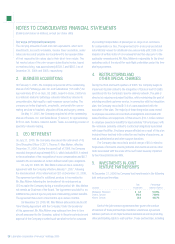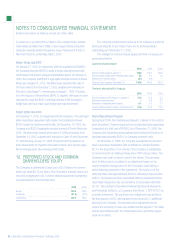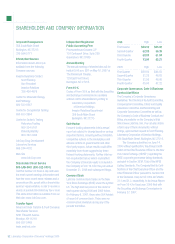LabCorp 2006 Annual Report Download - page 48
Download and view the complete annual report
Please find page 48 of the 2006 LabCorp annual report below. You can navigate through the pages in the report by either clicking on the pages listed below, or by using the keyword search tool below to find specific information within the annual report.
NOTES TO CONSOLIDATED FINANCIAL STATEMENTS
(Dollars and shares in millions, except per share data)
46 Laboratory Corporation of America® Holdings 2006
............................... ........
.......................................
The following table shows a summary of nonvested shares for
the year ended December 31, 2006:
Weighted-
Average
Number of Grant Date
Shares Fair Value
Nonvested at January 1, 2006 1.0 $45.16
Granted 0.2 58.60
Vested (0.2) 41.58
Adjustments 0.1 48.10
Nonvested at December 31, 2006 1.1 $48.01
As of December 31, 2006, there was $19.7 of total unrecognized
compensation cost related to nonvested restricted stock and perfor-
mance share-based compensation arrangements granted under the
stock incentive plans. That cost is expected to be recognized over
a weighted-average period of 1.5 years.
Employee Stock Purchase Plan
The Company has an employee stock purchase plan, begun in 1997 and
amended in 1999 and 2004, with 4.5 million shares of common stock
authorized for issuance. The plan permits substantially all employees
to purchase a limited number of shares of Company stock at 85% of
market value. The Company issues shares to participating employees
semi-annually in January and July of each year. Approximately 207,
209, and 247 thousand shares were purchased by eligible employees
in 2006, 2005 and 2004 respectively. For 2006, expense related to the
Company’s employee stock purchase plan was $2.3.
The Company uses the Black-Scholes model to calculate
the fair value of the employee’s purchase right. The fair value of
the employee’s purchase right and the assumptions used in its
calculation are as follows:
2006 2005 2004
Fair value of the employee’s purchase right $11.48 $14.40 $10.99
Valuation assumptions
Risk free interest rate 5.0% 2.8% 1.3%
Expected volatility 0.1 0.1 0.2
Expected dividend yield 0.0% 0.0% 0.0%
15. COMMITMENTS AND
CONTINGENT LIABILITIES
The Company was an appellant in a patent case originally filed by
Competitive Technologies, Inc. and Metabolite Laboratories, Inc. in
the United States District Court for the District of Colorado. After a
jury trial, the district court entered judgment against the Company for
patent infringement, with total damages and attorney’s fees payable
by the Company of approximately $7.8. The underlying judgment
has been paid. The Company vigorously contested the judgment and
appealed the case ultimately to the United States Supreme Court. On
June 22, 2006, the Supreme Court dismissed the Company’s appeal
and the case has been remanded to the District Court for further
proceedings including resolution of a related declaratory judgment
action initiated by the Company addressing the plaintiffs’ claims for
post trial damages. The Company does not expect the resolution of
these issues to have a material adverse effect on its financial position,
results of operations or liquidity.
The Company is also involved in various claims and legal actions
arising in the ordinary course of business. These matters include, but
are not limited to, intellectual property disputes, professional liability,
employee related matters, and inquiries from governmental agencies
and Medicare or Medicaid payers and managed care payers request-
ing comment on allegations of billing irregularities that are brought
to their attention through billing audits or third parties. In the opinion
of management, based upon the advice of counsel and consideration
of all facts available at this time, the ultimate disposition of these
matters is not expected to have a material adverse effect on the
financial position, results of operations or liquidity of the Company.
The Company is also named from time to time in suits brought under
the qui tam provisions of the False Claims Act. These suits typically
allege that the Company has made false statements and/or certifica-
tions in connection with claims for payment from federal health care
programs. They may remain under seal (hence, unknown to the
Company) for some time while the government decides whether to
intervene on behalf of the qui tam plaintiff. Such claims are an
inevitable part of doing business in the health care field today and,
in the opinion of management, based upon the advice of counsel
and consideration of all facts available at this time, the ultimate
disposition of those qui tam matters presently known to the Company
is not expected to have a material adverse effect on the financial
position, results of operations or liquidity of the Company.
The Company believes that it is in compliance in all material
respects with all statutes, regulations and other requirements
applicable to its clinical laboratory operations. The clinical laboratory
testing industry is, however, subject to extensive regulation, and the
courts have not interpreted many of these statutes and regulations.
There can be no assurance therefore that those applicable statutes
and regulations might not be interpreted or applied by a prosecutorial,
regulatory or judicial authority in a manner that would adversely affect
the Company. Potential sanctions for violation of these statutes and
regulations include significant fines and the loss of various licenses,
certificates and authorizations.






















